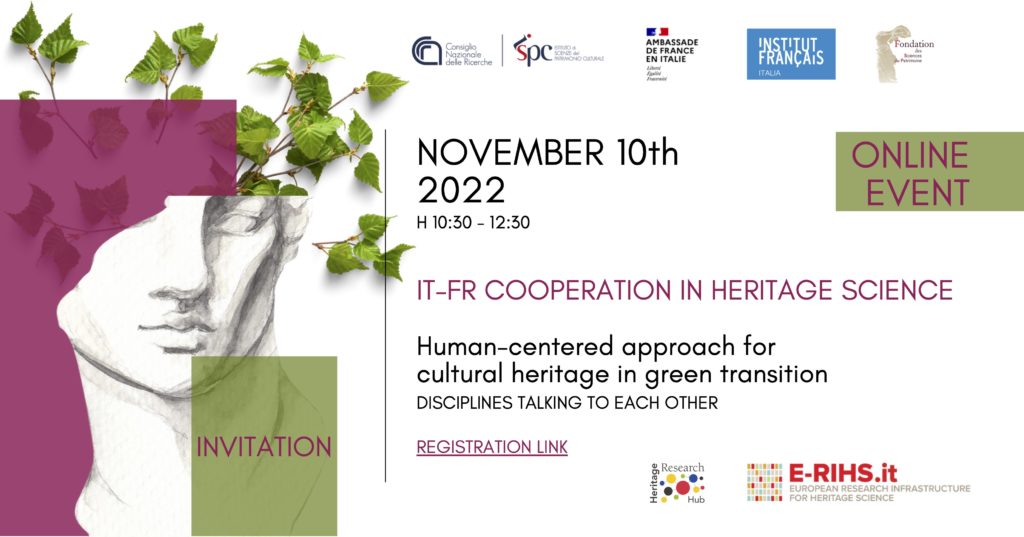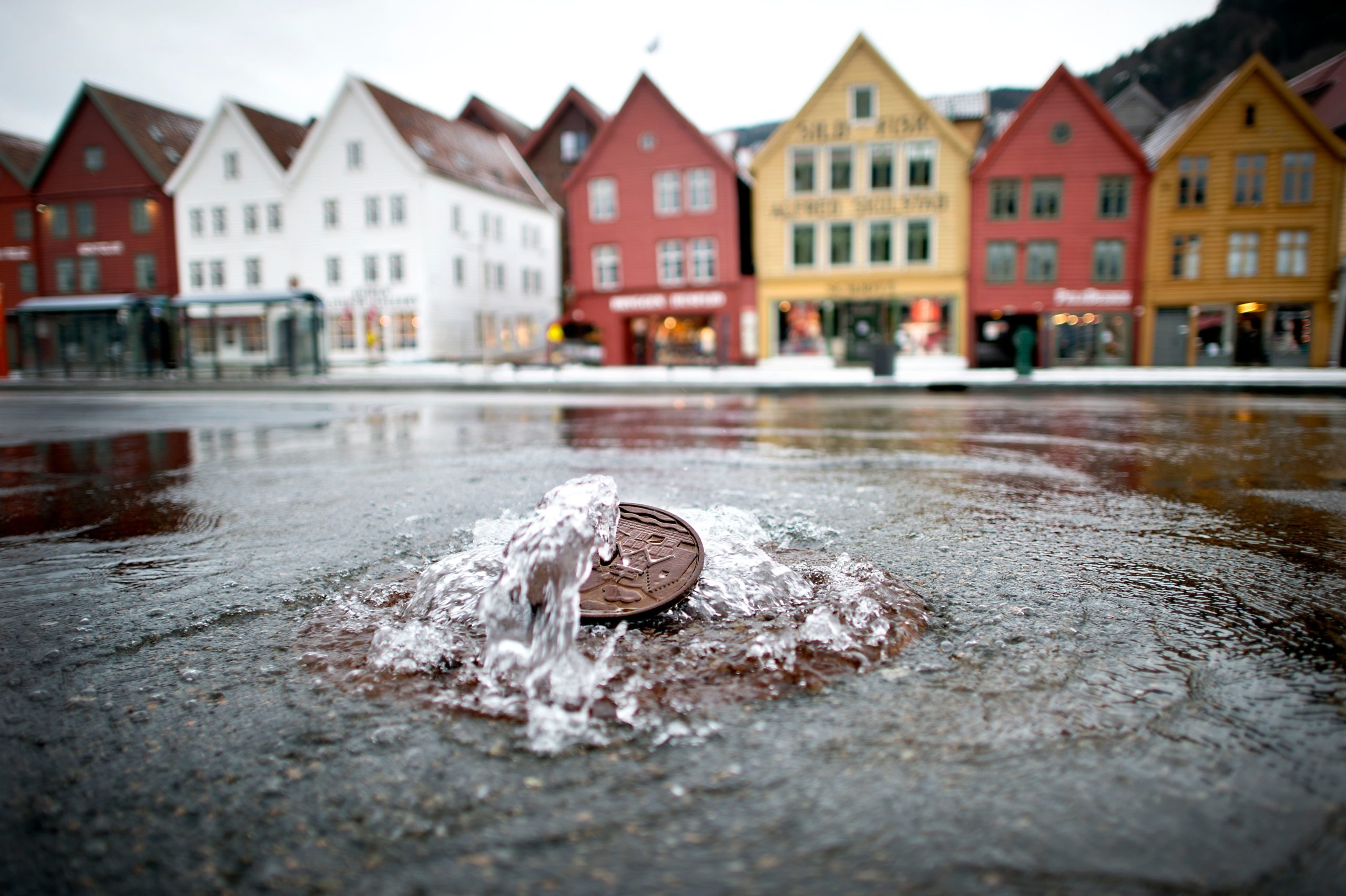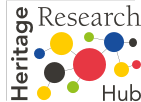
In the wake of the impulses given by the Quirinal Treaty, which emphasizes the field of cultural heritage as a field of cooperation between Italy and France, the Istituto di Scienze del Patrimonio Culturale del Consiglio Nazionale delle Ricerche, the Fondation des Sciences du Patrimoines, the Institut Français Italia, and the French Embassy in Italy are pleased to invite you to a workshop around the place of cultural heritage in the green transition. To register for the upcoming workshop, please follow this Zoom link. To check out the workshop programme, please follow this document link.
The workshop will be a sequel to a debate, organized the day before at Palazzo Farnese in Rome, around the theme “Heritage and sustainable development”, held by the Institut Français Italia and the company EDISON. It is part of the Franco-Italian bilateral cooperation on heritage science which is based on the recognized excellence of the two countries on several long-term joint research initiatives. Italy will host the statutory headquarters of the European Infrastructure for Heritage Science (E-RIHS) which is in the process of forming a consortium, for a European research infrastructure ERIC, by 2023. France leads the Joint Programming Initiative on Cultural Heritage and Global Change (JPI CH) and the project that will lead to the creation of an Alliance for Research on Cultural Heritage in Europe (ARCHE).
The workshop aims to bring together even more Italian and French researchers working in the field of heritage sciences on the urgent topic of climate change, the impact it has on cultural heritage and the way in which cultural heritage can be a driver of resilience, a capital of knowledge and a source of creativity and innovation for the ecological transition.
The bilateral meeting will be the first in a series and will start the discussion from the White Paper “Cultural Heritage and Climate Change ). Change: New challenges and perspectives for research,” which presents a certain number of priorities, research perspectives and also proposes a list of instruments to be put in place to support the development of this scientific field and support the activities of organizations engaged in climate action.
You can read the official presse release here (Italian and French). To learn more about the event, please visit the website of CNR ISPC. Presentations from the first workshop are now available for consultation, please find them attached below.
Chiara Bortolotto
The Safeguarding of Intangible Cultural Heritage and Sustainable Development. Toward a green transition?
Conceptualized as “living heritage” and characterized by intrinsic links with the economy, environment, and society, Intangible Cultural Heritage (ICH) explicitly introduces new issues and concerns within the realm of heritage policies, which go far beyond those conventionally associated with conservation. Drawing on participant observation of ICH governance within the governing bodies of the Convention for the Safeguarding of the ICH on the one hand, and of the preparation of a nomination to the UNESCO Representative List in an Italian town on the other hand, I shed light on the disruptions in heritage representations when heritage work becomes more about making plans for the future than engaging with the past. In tackling the temporality regime underpinning ICH, this paper highlights an important paradigm shift from “conservation” aimed at perpetuating authenticity to “safeguarding,” entailing instead the integration of change. I argue that this shift not only challenges established heritage theory and practice, but opens up new possibilities for accelerating a green transition.
Giulio Lucarini & Anita Radini
Human adaptation to and impact on the Environment
In the last decades, archaeology and paleo-environmental disciplines have largely contributed to a wider understanding of human responses to climate changes of the past, especially in relation to socio-cultural phenomena of great importance, such as demographic fluctuations, migrations or technological adaptation. That provided insights for a better management of similar problems in present days.
These same disciplines also explore what the impact of human activities on Planet Earth may have been in the distant past. If, in fact, the heavy acceleration that has been produced since the mid-nineteenth century is evident, the diachronic analysis of the complex relationships that governed human beings and environment, shows that this impact may have occurred even before the Industrial Revolution and that it can be traced back to the first agricultural and pastoral production experiences of the planet.
The study concerning the origins of these economies and their long-term environmental impact is today of great relevance by reason of the role that these subsistence strategies still play globally among communities, but also for the debate on their ecological effects. At the same time, studying the adaptations of ancient societies to situations of environmental stress can help address responses to climate change and the increasing aridification that different regions of the planet are experiencing today.
Ann Bourges
Integrating data from the past to build the future: heritage a source and a showcase of innovation
Heritage is often also a source of inspiration, inspiration with regard to the materials used, the techniques, the craftsmanship, the know-how. Tangible and intangible goods are also an asset, a tool for innovation to bring new solutions. By drawing inspiration from the past and the virtuous riches of our heritage, solutions for preservation, but also for better living are within reach. There is as much to be done in identifying the effects as in identifying the innovative potential offered by heritage.
The European New Bauhaus movement bears witness to this and heritage has a huge role to play in these actions to reduce our greenhouse gas emissions. The heritage must be a showcase for innovation, listing all the materials and virtuous techniques that can be integrated into the main objective of the European green pact, zero carbon by 2050. Integrating data from the past to better build the future today.
Alessandra Marasco
Cultural heritage experiences in the twin transition: promoting sustainable visitor behaviours
The role of cultural heritage in inspiring action for climate mitigation and sustainable futures is an emerging area of research (JPI Cultural Heritage & JPI Climate, 2022). Visitors represent an important target audience for raising awareness and encouraging behavioural change towards more sustainable practices to protect cultural heritage, reduce environmental impacts and reach climate neutrality goals (Potts, 2021; Markham et al., 2016). Promoting sustainable visitor behaviours for the conservation of cultural heritage and the environment is thus a strategic priority for cultural heritage institutions, but remains challenging, particularly with regard to how sustainable behaviours can be integrated in the design of visitor-centred experiences (Ardoin, Schuh, and Khalil, 2016).
With the aim to contribute to the debate in this field, this presentation focuses on how to promote sustainable visitor behaviours through cultural heritage experiences from the twin transition perspective. It provides insights into the understanding of sustainable visitor behaviours, key antecedents identified by literature and the opportunities offered by digital technologies. Building on an experience design approach (Tussyadiah, 2014, 2017), guiding principles are presented for designing experiences involving digital technologies that are effective in encouraging and engaging visitors in sustainable behaviours.
Thomas Mouzard & Sofia Pescarin
For a relational and integrated approach to safeguarding tangible and intangible heritage
The safeguarding of intangible cultural heritage (ICH) contributes by definition to the green transition because, in application of the 2003 Unesco Convention, it must respect the objectives of sustainable development (SD), of which ecology is one of the 3 axes. According to the Operational Directives revised in 2016, States Parties strive to “strengthen the role of ICH as a factor and guarantor of SD”. After summarizing the main orientations and principles of this international normative instrument in this field, this communication will begin by presenting a summary assessment and the issues that arise in France in their implementation. Thirdly, we will approach the problem from an anthropological point of view by highlighting the impossibility of responding to the ecological challenges of our time without reconsidering our ways of relating to the living, and getting out of the double dichotomy humanity / nature, modernities / traditions.
Valeria Di Tullio
Green Conservation and E-RIHS: experiences of access to research infrastructures
As several aspects of society, also the conservation of cultural heritage is moving towards a more sustainable approach. In this presentation, several examples of access to the Italian node of E-RIHS (European research infrastructure for heritage science) will be presented showing the role of multi-disciplinary collaboration between scientists, conservators, art historians and others to promote the safeguarding of cultural heritage and enhance its sustainability through better-coordinated research and innovation. The employment and the dissemination of new approaches of green conservation can be thus successfully improved by providing access to high-level scientific tools, data, advanced knowledge as well as to innovative methodologies applied to the Cultural Heritage.
Piero Baglioni
Green technologies and materials for Cultural Heritage Conservation
European Cultural Heritage (CH) is a crucial resource that must be maintained, preserved and accessible, to counteract degradation enhanced by unfavorable environmental conditions and climate changes. Traditional conservation methodologies lack durability, sustainability and cost-effectiveness, and are typically based on energy-consuming processes or non-environmentally friendly materials.
Coping with these issues, new solutions based on green and sustainable materials and methods, to preserve, conserve and restore have been proposed and will be further developed within the “green matrix” and the European Green deal. In this talk I will briefly highlight: 1) Protective coatings based on green materials from waste and plant proteins, with self-heling and reversibility character, possibly functionalized with organic/inorganic nanoparticles to impart VOC capture, anti-corrosion and barrier behaviors; 2) Foams and packaging materials made by biodegradable/compostable polymers from renewable sources to control T/RH. 3) Consolidants based on natural polymers from renewable sources, to mechanically strengthen weak artifacts. 4) Gels and cleaning fluids inspired by the most advanced systems currently available to conservators, improving them according to green and circular economy.
Edwige Pons Branchu
The history of water in urban heritage, research avenues for water management in the future city
In densely populated areas, urban development has a significant impact on the quality of natural water, and in particular that of near-surface aquifers. The quality of these waters is poorly known, as are the factors that influence it (sources of pollution for example), and are not used as a resource. We present here the study of the near surface waters of Paris and its surroundings. The innovative approach developed within the framework of several projects aimed to put in place analytical tools to reconstruct the historical evolution of water quality. This is based on the study of fine limestone deposits formed by seepage water over time and found in historic aqueducts, catacombs or other underground structures. It is thus possible to trace the temporal evolution of certain sources of pollution in connection with urban development or human activities, and better constrain them. This approach is also underway for the study of the water supplying the fountains of the Palace of Versailles.
This methodology could be applied to other sites in France and Italy. Indeed, the better knowledge of the history of urban waters or highly anthropized areas makes it possible to discuss their possible valorization as an alternative resource, in a context of scarcity of water resources.
Documents

